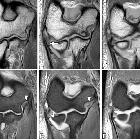Osborne-Cotterill lesion




Osborne-Cotterill lesions represent a shear or depression fracture of the posteroinferior aspect of the capitellum and an avulsed fragment in posterolateral elbow most commonly seen in patients with chronic posterolateral rotatory instability.
Pathology
It is thought to be due to posterolateral subluxation or dislocation during hyperextension of the elbow joint which can result in kissing contusion or impaction of the anterior radial head into posteroinferior capitellum with resultant depressed fracture or contusion as well as in some instances avulsion of the humeral attachment of the lateral ulnar collateral ligament. The mechanism is similar to that of Hill-Sachs deformity and Bankart lesions in anterior shoulder dislocations.
History and etymology
Osborne and Cotterill first described an osteochondral fracture in the posterolateral margin of the capitellum with or without a defect in the radial head in patients with recurrent elbow joint dislocation and posterolateral instability in 1966. In 2008, Morrey et al. suggested the term "Osborne-Cotterill lesion" for this condition.
Siehe auch:

 Assoziationen und Differentialdiagnosen zu Osborne-Cotterill-Läsion:
Assoziationen und Differentialdiagnosen zu Osborne-Cotterill-Läsion:



